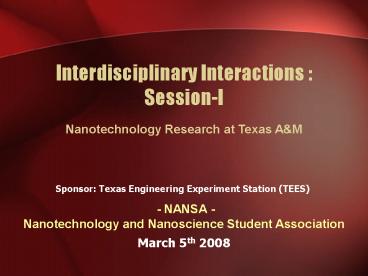Interdisciplinary Interactions : Session-I - PowerPoint PPT Presentation
1 / 11
Title:
Interdisciplinary Interactions : Session-I
Description:
... chirality metallic or semi-conducting type Can also demonstrate the synthesis of CNT with a high ... Development of processes to synthesize nanoparticles, ... – PowerPoint PPT presentation
Number of Views:132
Avg rating:3.0/5.0
Title: Interdisciplinary Interactions : Session-I
1
Interdisciplinary Interactions Session-I
Nanotechnology Research at Texas AM
Sponsor Texas Engineering Experiment Station
(TEES)
- NANSA - Nanotechnology and Nanoscience Student
Association
- March 5th 2008
2
MECHANICAL ENGINEERING Debjyoti
Banerjee dbanerjee_at_tamu.edu 845-4500 310
Engr/Phys
Ph.D. Mechanical Engineering, University of
California (UCLA) 1999M.S. Mechanical
Engineering, University of California (UCLA)
1998M.S. Mechanical Engineering, University of
Mississippi, 1995B.S. Mechanical Engineering,
Indian Instt. of Technology (I.I.T.), 1992
- Research
- Nanolithography A method to synthesize carbon
nanotube (CNT) with controlled (single) chirality
metallic or semi-conducting type - Can also demonstrate the synthesis of CNT with a
high number (spatial) density and with a
precisely defined location for the growth of CNT - Nanofluidics - Molecular dynamics (MD) simulation
of nanoscale flow - Convective heat transfer using nanofluids
http//www1.mengr.tamu.edu/mpf/index.html
3
Dip Pen Nanolithography (DPN) techniques were
used to deposit metal catalysts at precisely
defined locations and pattern precisely defined
sizes on a variety of substrates such as gold,
silicon, silicon nitride, etc.
DPN process enabled precise control of the
composition of the deposited catalyst. After
deposition of catalysts, a low temperature
Chemical Vapor Deposition (CVD) process was used
to synthesize CNT.
4
MECHANICAL ENGINEERING Jaime Grunlan jgrunlan_at_tamu
.edu 845-3027 218 Engr/Physics
Ph.D. Materials Science and Engineering,
University of Minnesota 2001 B.S. Chemistry,
North Dakota State University 1997
- Research
- Research focuses on polymer nanocomposites with
properties that rival metals and ceramics, while
maintaining beneficial polymer mechanical
behavior - Areas of focus
- Layer-by-layer assembly of multifunctional
polymer nanocomposites focused on transport
behavior (electrical, thermal, and mass) and
applications in sensors, capacitors, electronics
packaging, gas separation membranes, etc - Tailoring nanocomposite microstructure and
properties with stimuli-responsive polymers and
high aspect ratio nanoparticles - Electrically conductive polymer nanocomposites
with high conductivity and low filler
concentration
http//www1.mengr.tamu.edu/PolymerNanoComposites/i
ndex.html
5
Robotic dipping system for layer-by-layer assembly
A variety of functional films can be produced
using the layer-by-layer (LbL), or electrostatic
self-assembly technique.
LbL-based thin films are currently being
evaluated for a variety of applications that
include drug delivery, molecular sensing, solid
battery electrolyte and membranes.
6
MECHANICAL ENGINEERING Hong Liang hliang_at_tamu.edu
862-2623 323 Engr/Phys
Ph.D. Materials Science and Engineering, Stevens
Institute of Technology 1992 M.S. Materials
Science and Engineering, Stevens Institute of
Technology 1987B.S. Materials Science and
Engineering, Beijing University 1983
- Research
- Development of processes to synthesize
nanoparticles, nanostructured bulk materials and
surface coatings with multi-properties - Development of nanomanufacturing processes to
fabricate nanostructures, nanodevices and sensors - Dr. Liangs group develops innovative processes
to generate nano-coatings, they also focus on the
development of nanofabrication processes - This process generates nano-scale phases through
simple mechanical manipulation in designed
chemical environments - Creation of nanowires with DNA
http//www1.mengr.tamu.edu/IG/
7
By stirring DNA into a chemical solution and
exposing it to ultraviolet light, Dr. Liangs
group has come up with a simple and cheap method
to create nanowires that could be used to create
tiny computers and medical devicesfeatured on
the Discovery channel.
This research focuses on the development of
nanofabrication processes. The process generates
nanometer length scale phases through simple
mechanical or chemical reaction methods, which
includes fundamental and practical aspects.
Fundamentally, the structure-surface properties
influenced by external energy is studied.
Materials involved in their research are
amorphous, nanocrsytalline, and piezoelectric
ones. The simplicity and flexibility of the
techniques is a significant advantage for
synthesis and characterization of
nano-structures. The potential applications fall
in nanomachining, assembly, nanosensors, and
development of MEMS and NEMS.
8
MECHANICAL ENGINEERING Hung-Jue
Sue hjsue_at_tamu.edu 845-5024 215 Engr/Phys
Ph.D. Macromolecular Science and Engineering,
University of Michigan 1988M.S. Mechanical
Engineering, University of Michigan 1987M.S.
Materials Science and Engineering, University of
Michigan 1985B.S. Chemical Engineering, Chung
Yuan University, Taiwan 1981
- Research
- Improvement in the mechanical properties of
surface functionalized CNT/epoxy composites - It is found that surface functionalization can
effectively improve the dispersion and adhesion
of CNTs in epoxy which leads to the enhancement
in mechanical properties of epoxy - Preparation of epoxy nanocomposites with ZrP of
different aspect ratios - a-zirconium phosphate (a-ZrP) crystals are
synthesized and then exfoliated because
crystalline a-zirconium phosphate has a much
larger lateral dimension compared with
semicrystalline a-ZrP and natural clay particles,
the exfoliated a-ZrP individual platelet shows a
much larger aspect ratio - Transparent Zinc Oxide (ZnO) nanocomposites
- PMMA/ZnO nanocomposite films are highly
transparent and show high UV-shielding efficiency
http//ptc.tamu.edu
9
Zinc Oxide (ZnO) quantum dots dispersed in epoxy
Novel method to pull debundle CNT - dispersed in
various solvents
Controllable exfoliation of Zirconium Phosphate
(ZrP)/Epoxy Nanocomposites
10
MECHANICAL ENGINEERING Xinghang
Zhang zhangx_at_tamu.edu 845-2143 326 Engr/Phys
Ph.D. Materials Science and Engineering, North
Carolina State University 2001M.S. Materials
Science and Engineering, Institute of Metal
Research, China 1998 B.S. Materials Science and
Engineering, Jilin University, China 1995
- Research
- Radiation induced defects in metallic nanolayers
and bulk nanostructured metals - Nanostructured materials for energy storage
applications - Synthesis and characterization of nanoparticles
- Nanoparticles have potential applications as
catalyst and in optical, electrical and magnetic
devices metallic nanoparticles can be
synthesized via physical vapor deposition
nanoparticles synthesized using this technique
has uniform particle size distributions - Nanoscale twinning in thin films
http//www1.mengr.tamu.edu/NTFG/index.html
11
High resolution TEM micrographs of a single Pt
nanoparticle
Pt nanoparticles synthesized via electron beam
evaporation has an average particle size of 3
nm
Simulation showing the strength of symmetric
(111) twin interface to block dislocation
transmission. (a) A perfect glide dislocation
with b 1/2 101 resides in the upper layer.
Unstrained. (b) The model is subject to pure
shear stresses such that the resolved shear
stress on the dislocation is 1.77GPa. The
dislocation is moving away from the twin
interface. A Shockley partial with b 1/6
remains at the interface

